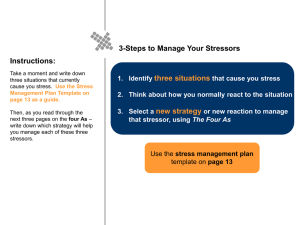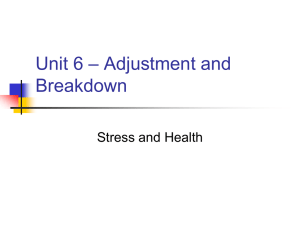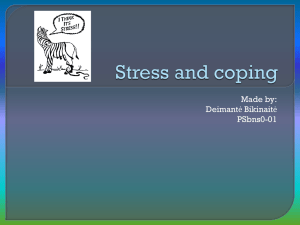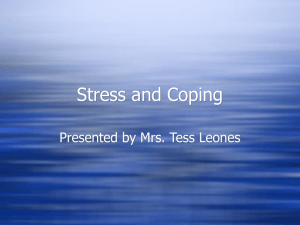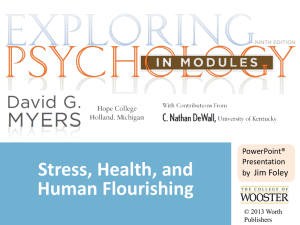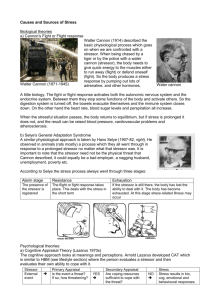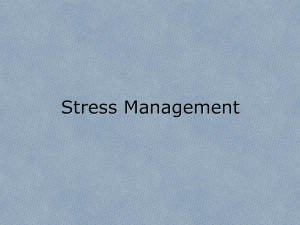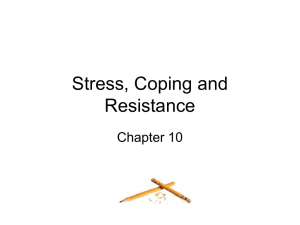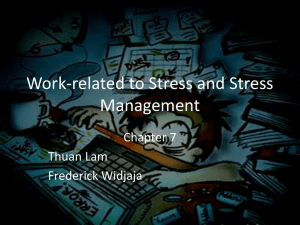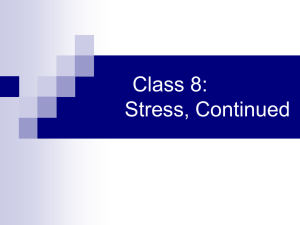Ciccarelli Chapter 11
advertisement
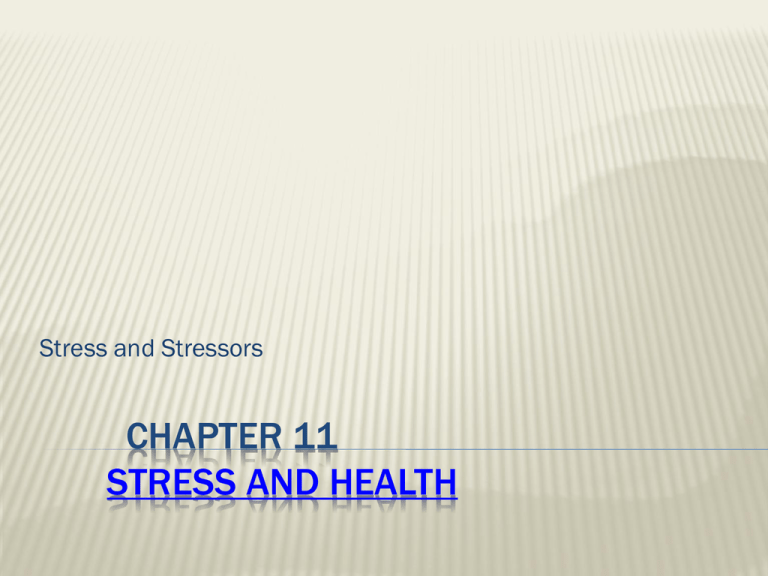
Stress and Stressors CHAPTER 11 STRESS AND HEALTH STRESS AND STRESSORS: A CONSEQUENCE OF LIVING Stress refers*to a complex set of reactions made by an individual under pressure to adapt; or it is a term used to describe the physical, emotional, cognitive, and behavioral responses to events that are appraised as threatening or challenging. Stressors are the source of the stress. The source can come from within a person or from an external source and range from relatively mild to severe. Two kinds of stressors: 1) Those that cause distress and 2) those that cause eustress. Distress- stressors that are perceived to cause some sort of biopsychosocial discomfort. Eustress are the effect of positive events, or the optimal amount of stress that people need to promote health and well-being. ENVIRONMENTAL STRESSORS _____________ is an unpredictable, large-scale event that creates a tremendous need to adapt and adjust as well as overwhelming feelings of threat. ______________ is a disorder resulting from exposure to a major stressor, with symptoms of anxiety, recurring nightmares, sleep disturbances, problems in concentration, and moments in which people seem to “relive” the events in dreams and flashbacks for as long as one month following the event. __________________ is a disorder resulting from exposure to a major stressor, with symptoms of anxiety, nightmares, etc., lasting for more than one month. The two events that appear to be the core of someone experiencing stress involves ______________ and __________. SOCIAL READJUSTMENT RATING SCALE SRRS – is an assessment tool that measures the amount of stress in a person’s life over a one-year period resulting from major life events. Persons that scored 300 and above were at an 80% chance of developing an illness (high blood pressure, ulcers, migraine headaches) or having an accident in the near future. College Undergraduate Stress Scale (CUSS) – is an assessment tool that measures the amount of stress in a college student’s life over a one-year period resulting from major ______________________. HASSLES _____________ are the daily annoyances of everyday life that may come from different sources depending on a person’s developmental stage, e.g., children ages 3-5 cited getting teased as their biggest daily hassle; adolescents (ages16-22) cited trouble at school or work; and the elderly cited a lack of ________________ as their biggest daily hassle. PSYCHOLOGICAL STRESSORS ______________ is the psychological experience produced by urgent demands or expectations for a person’s behavior that come from an outside source. Another factor that increases a person’s experience of stress is the degree of _______________ that the person has over a particular event or situation. The less control a person has, the greater the degree of ___________. Another factor involved in contributing to a person’s stress level is the concept called frustration. Frustration is the psychological experience produced by the _____________ of a desired goal or fulfillment of a perceived need. Frustrations can be external or internal. External frustrations involve those life events that are outside of you such as car breaking down, and experiencing a theft of one’s belongings. Internal frustrations occur when the goal or need cannot be attained because of an internal or personal characteristics, e.g. wanting to dunk a basketball and you’re 4’10”. TYPICAL RESPONSES TO FRUSTRATION Persistence – The continuation of efforts to get around whatever is causing the frustration. Ex. Use of a lawyer by Tiger Wood to explain his vehicular accident. Aggression – Is an action meant to harm or destroy. Displaced aggression – Is aggressing on a less threatening object/target. Displacement – Psychological defense mechanism in which emotional reactions and behavioral responses are shifted to targets that are more available or less threatening than the original target. A fourth possible reaction to frustration is escape or ______________; leaving the presence of a stressor, either literally or by a psychological withdrawal into fantasy, drug abuse, or apathy. Suicide - Talking about committing suicide is a kind of “dress rehearsal” and we need to take the person seriously even if they said, “I’m just kidding”. AGENTS OF STRESS:CONFLICTS Approach-approach conflict – conflict occurring when a person must choose between two desirable ______________. Avoidance-avoidance conflict – conflict occurring when a person must choose between two _________________ goals. Approach-avoidance conflict – conflict occurring when a person must choose or not choose a goal that has both __________ and _______________ aspects. Double approach-avoidance conflict – conflict in which the person must decide between two goals, with each goal possessing both positive and negative aspects. Multiple approach-avoidance conflict – conflict in which the person must decide between more than two goals, with each goal possessing both positive and negative aspects. PHYSIOLOGICAL FACTORS: STRESS AND HEALTH The autonomic nervous system (ANS) – Is apart of the human nervous system that is responsible for all ___________, ______________, and ______________________ activities. The ANS consists of two divisions, the ____________ and the ____________. Both figure prominently in the body’s physiological reactions to stress, the general adaptation syndrome. Psychologist Hans Selye was the founder of the field of research concerning stress and its effects on the human body. He studied the sequence of physiological reactions that the body goes through when adapting to a stressor; known as the general adaptation syndrome (GAS) and consists of three stages: Alarm, Resistance, and Exhaustion. GENERAL ADAPTATION SYNDROME Hans Selye viewed stress as a three-stage mobilization of the body’s resources to combat real or perceived threats to our well-being. The first stage he called: Alarm: Is when the body first reacts to a stressor, the _________________ nervous system is activated. The adrenal glands release hormones(norepinephrine) that increase heart rate, blood pressure, and the supply of blood sugar, resulting in a burst of energy. Resistance: As the stress continues, the body settles into sympathetic division activity, continuing to release the stress hormones that help the body fight off or resist the stressor. One of the hormones released under stress, noradrenaline, seems to affect the brain’s processing of pain, so that when under stress a person may experience a kind of analgesia (insensitivity to pain). Exhaustion: Exhaustion occurs when the body’s resources are gone. Exhaustion can lead to the formation of stress-related diseases- high blood pressure or a weakened immune system- or the death of the organism if outside help is unavailable. When the stressor ends, the parasympathetic division activates and the body attempts to replenish its resources. Selye argued that there is a connection between stress and certain “diseases of adaptation”. Most common are ulcers and high blood pressure. IMMUNE SYSTEM AND STRESS Immune system –refers to a system of cells, organs, and chemicals of the body that responds to attacks from diseases, infections and injuries. Psychoneuroimmunology is the study of the effects of psychological factors such as stress, emotions, thoughts, and behavior on the immune system. Stress triggers the same response in the immune system that infection triggers, except it starts in the brain rather than in the blood stream. RISK FACTORS FOR HEART DISEASE The more stress workers were exposed to in their work environment and home life, the more likely they were to exhibit the risk factors: obesity, high blood sugar, high triglycerides (a type of fatty acid found in the blood), and low levels of HDL or good cholesterol. Cancer cells divide without stopping. Natural killer cells are the immune system cells responsible for suppressing viruses and destroying tumor cells. Studies have shown that children in families experiencing ongoing stress are more likely to develop fevers with illness than are other children. THE INFLUENCE OF COGNITION AND PERSONALITY ON STRESS Richard Lazarus developed a cognitive view of stress called the cognitivemediational theory of emotions, in which the way people think about and appraise a stressor is a major factor in how stressful that particular stressor becomes. Primary appraisal - Is the first step in assessing stress, which involves estimating the severity of a stressor and classifying it as either a threat or a challenge. Secondary appraisal - Is the second step in assessing a threat, which involves estimating the resources available to the person for coping with the stressor. Type A personality are persons who are ambitious, time conscious, extremely hardworking, and tend to have high levels of hostility and anger as well as being easily annoyed. Type B personality are persons who are relaxed and laid-back, less driven and competitive and slower to anger than Type A. Type C personality are pleasant but repressed persons, who tend to internalize his or her anger and anxiety and who find expressing emotions difficult. The Hardy personality are persons who seem to thrive on stress but lacks the anger and hostility of the Type A personality. Optimists are people who expect ____________ outcomes. Pessimists are people who expect ____________ outcomes. Burnout refers to negative changes in thoughts, emotions, and behavior as a result of prolonged stress or frustration. Acculturative stress is the stress resulting from the need to change and adapt a person’s ways to the majority culture. Social support system is the network of family, friends, neighbors, coworkers, and others who can offer support, comfort, or aid to a person in need. Coping strategies are actions that people can take to master, tolerate, reduce, or minimize the effects of stressors. Problem-focused coping are coping strategies that try to eliminate the source of a stress or reduce its impact through direct actions. Emotion-focused coping are coping strategies that change the impact of a stressor by changing the emotional reaction to the stressor. Psychological defense mechanisms are unconscious distortions of a person’s perception of reality that reduce stress and anxiety. Learn the meaning of: Denial, Repression, Projection, & Reaction formation. Meditation refers to mental series of exercises meant to refocus attention and achieve a trancelike state of consciousness. Concentrative meditation is a form of meditation in which a person focuses the mind on some repetitive or unchanging stimulus so that the mind can be cleared of disturbing thoughts and the body can experience relaxation. Receptive meditation is a form of meditation in which a person attempts to become aware of everything in immediate conscious experience, or an expansion of consciousness. FOCUS ON WELLNESS Exercise Get involved with others Get some sleep Eat healthy foods Have some fun Manage your time Take a deep breath The End Study Study Study
